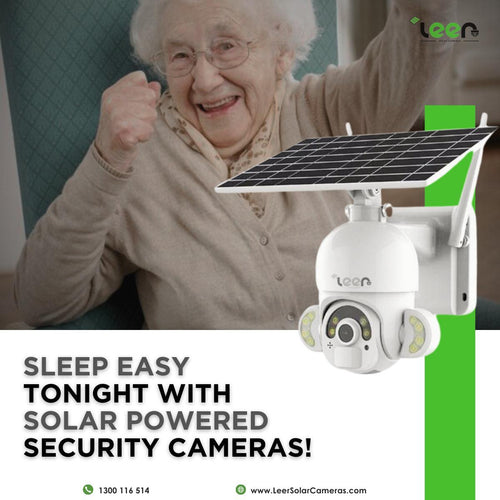The Advantages of Solar-Powered WiFi Cameras: Enhancing Security with Sustainable Technology
Introducing solar-powered WiFi/4G cameras – the innovative solution that brings together security and sustainability. With the increasing need for reliable and efficient security measures, these cameras offer numerous advantages that are hard to ignore.
By harnessing the power of the sun, solar-powered WiFi cameras provide a self-sustaining energy source, eliminating the need for traditional power supplies or batteries. This not only reduces costs but also makes installation incredibly simple and flexible, allowing for placement in remote locations where power supply may be limited.
In addition to their green capabilities, these cameras offer seamless connectivity through WiFi, enabling real-time monitoring and remote access from anywhere in the world. Whether you're on vacation or in the office, you can easily keep an eye on your property and loved ones through a user-friendly mobile app.
Furthermore, the advanced features of solar-powered WiFi cameras include motion detection, night vision, and high-definition video quality, ensuring round-the-clock surveillance and crisp footage for enhanced security.
Embrace the future of security with the advantages of solar-powered WiFi cameras – a sustainable and effective solution for safeguarding your property and peace of mind.
How Solar-Powered WiFi Cameras Work
Solar-powered WiFi cameras are an innovative fusion of technology and environmental sustainability, designed to provide continuous surveillance without relying on traditional power sources. At the heart of these devices lies a solar panel that captures sunlight and converts it into electricity, powering the camera and its internal functions. This energy is stored in rechargeable batteries, ensuring that the camera operates smoothly even during periods of low sunlight or inclement weather. By utilizing solar energy, these cameras eliminate the need for wired power connections, making them an ideal option for remote or off-grid locations.
The integration of WiFi technology further enhances the functionality of solar-powered cameras. These devices connect to your home or business's wireless network, allowing users to access live feeds and recorded footage remotely via a smartphone app or web portal. This connectivity is crucial for real-time monitoring, enabling property owners to keep an eye on their premises from anywhere in the world. The combination of solar energy and WiFi capability not only results in a sustainable security solution but also offers convenience and flexibility in camera placement and usage.
Additionally, most solar-powered WiFi cameras come equipped with advanced features such as motion detection, night vision, and high-definition video recording. Motion sensors trigger the camera to begin recording when activity is detected, reducing unnecessary footage and conserving energy. Night vision technology allows for clear surveillance even in low-light conditions, while high-definition capabilities ensure that the captured images are sharp and detailed. This comprehensive approach to security makes solar-powered WiFi cameras a formidable choice for anyone looking to enhance their safety measures without compromising on sustainability.
Why Choose Products from Leer Solar Cameras?
Leer Solar Cameras stands out in the market for several compelling reasons:
-
High Quality: Leer ensures that all its solar-powered cameras are manufactured with top-notch materials and advanced technology to guarantee durability and reliability in various environments.
-
Innovative Features: With cutting-edge functionalities like motion detection, night vision, and dual-way audio, Leer Solar Cameras offer comprehensive solutions tailored to meet today’s security needs.
-
Eco-Friendly Solutions: By utilising solar energy, Leer cameras provide sustainable security without contributing to carbon emissions, helping customers align their security needs with eco-conscious values.
-
User-Friendly Experience: Their products are designed for easy installation and use, ensuring that customers can set up and operate their security systems without needing professional assistance.
-
Customer Support: Leer is committed to providing excellent customer service and support, offering guidance and assistance whenever needed to ensure complete customer satisfaction.
Key Products Overview
| SC11 | F20 | Y5 | MG93 | |
|---|---|---|---|---|
| Resolution | 2MP | 4MP | 8MP | 8MP |
| Pan Angle | 355 | 355 | 355 | 350 |
| Tilt Angle | 100 | 100 | 90 | 90 |
| Zoom | 3X Digital | 4x Digital | 10X Optical | 36X Optical |
| Solar Panel Power | 3.5 Watts | 6 Watts | 6 Watts | 60W |
| Battery | 6400mAh | 12000mAh | 20000mAh | 40000mAh |
| Solar Panel Attachment | Detached | Detached/Integrated | Detached/Integrated | Detached |
| Connectivity | Wifi OR 4G | Wifi OR 4G | Wifi OR 4G | Wifi/4G/POE |
| 2-Way Voice | YES | YES | YES | YES |
| Motion Detection | YES | YES | YES | YES |
| Infrared Night Vision | YES | YES | YES | YES |
| Audible Alarm | YES | YES | YES | YES |
| Human Tracking | NO | NO | YES | NO |
| Flood Light | YES | YES | YES | YES |
| SD Memory | YES | YES | YES | YES |
| Cloud Storage | Subscription | Subscription | Subscription | YES |
| Waterproof Rating | IP65 | IP65 | IP65 | IP65 |
| Warranty | 1 Year | 2 Years | 2 Years | 2 Years |
| App Name | uBox | uBox | NiView | CamHi Pro |
Installation and setup of solar-powered WiFi cameras
Installing solar-powered WiFi cameras is a straightforward process that offers flexibility and convenience. Unlike traditional security cameras that require complex wiring and electrical connections, solar-powered models can be installed in various locations without the need for a power outlet. This capability makes them ideal for outdoor settings, such as gardens, driveways, or remote properties. Users can choose optimal locations for surveillance that may have been previously challenging due to power constraints.
The installation process typically involves mounting the camera securely to a surface, such as a wall or pole, while ensuring the solar panel receives direct sunlight for maximum energy absorption. Most manufacturers provide comprehensive installation guides, complete with step-by-step instructions and necessary mounting hardware. This user-friendly approach means that many individuals can install the cameras themselves without professional assistance, further reducing costs and simplifying the setup process.
Once the camera is physically installed, connecting it to a WiFi network is usually a seamless experience. Many solar-powered WiFi cameras come equipped with user-friendly mobile apps designed to guide users through the setup process. These applications often include features like real-time monitoring, video recording, and customizable settings, allowing users to tailor the camera's performance to their specific needs. With just a few taps on a smartphone, individuals can have their solar-powered WiFi camera up and running, providing instant peace of mind and enhanced security.
Maintenance and troubleshooting tips
While solar-powered WiFi cameras are designed for durability and low maintenance, some essential upkeep is necessary to ensure optimal performance. Regularly checking the solar panels for dirt, dust, or debris is crucial, as any obstruction can impede the panel's ability to absorb sunlight effectively. Cleaning the panels with a soft cloth or sponge can help maintain their efficiency, ensuring that the camera remains fully powered. Additionally, it’s important to inspect the camera housing for signs of wear or damage, particularly after severe weather events, to ensure that the camera continues to function properly.
Another critical aspect of maintenance involves software updates. Many solar-powered WiFi cameras rely on firmware updates to enhance security features, improve functionality, and fix any potential bugs. Users should regularly check for updates through the camera's associated mobile app or manufacturer’s website. Keeping the software up to date not only ensures optimal performance but also protects the camera from potential vulnerabilities that could be exploited by malicious actors.
In the event of troubleshooting issues, users can often resolve common problems by following simple guidelines. If the camera is not recording or transmitting video, checking the WiFi connection is advisable, as connectivity issues can disrupt functionality. Additionally, if the camera appears to be offline, ensuring that the solar panel is receiving adequate sunlight is essential. In cases where problems persist, consulting the manufacturer's customer support or online resources can provide further assistance, ensuring that users maintain a reliable and effective security system.
Conclusion
In conclusion, solar-powered WiFi cameras represent a significant advancement in security technology, combining sustainability with cutting-edge features to meet the demands of modern surveillance. Their ability to operate independently of traditional power sources not only simplifies installation but also reduces ongoing costs, making them an appealing choice for homeowners and businesses alike. The enhanced security capabilities, including motion detection and night vision, ensure that users can protect their properties effectively, regardless of environmental conditions.
As society increasingly prioritizes sustainability, adopting solar-powered technology for security solutions aligns with broader environmental goals. By choosing these innovative cameras, consumers can contribute to a greener future while enhancing their safety measures. The success stories of various users underscore the effectiveness and practicality of solar-powered WiFi cameras, proving that they can deliver reliable surveillance in diverse settings.

